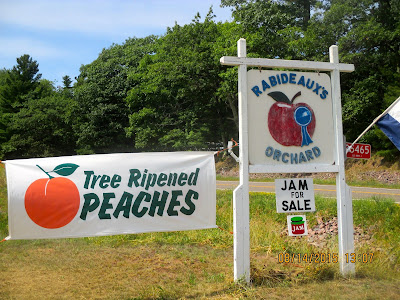 |
| IRONWOOD, A FOREST UNDERSTORY TREE, ALONG THE WOODSY EDGE OF CHEQUAMEGON ROAD... |
 |
| ...WITH ELM-LIKE LEAVES... |
 |
| ...AND PANICLES OF SEEDS REMINISCENT OF HOPS... |
 |
| FLAKY, PEELING BARK OF IRONWOOD (PHOTO FROM NOVEMBER 2014) |
 |
| DORMANT MALE FLOWER BUDS, USUALLY OCCURRING IN THREES (PHOTO FROM NOVEMBER 2014) |
Monday, 9:00 AM. 63 degrees F on both thermometers. Wind SW, light with slightly stronger gusts. The sky is partly cloudy with considerable haze. The humidity is 95% and the barometer steady, at least for a while, at 29.88". It should be a pleasant day.
As I was driving down Chequamegon Road yesterday several pendulous, creamy-white, flower-like structures on a roadside tree caught my eye. Seldom seen, unless walking in a late summer northern woods, they were the immature seed heads of the ironwood, or hop hornbeam.
Ironwood, Ostrya virginia, in the Birch (Betulaceae) Family, is a common component of the northern mixed hardwood forest. A small understory tree, it seldom reaches a height of more than twenty or thirty feet under a canopy of oak, mapple, basswood and conifers such as balsam fir and white spruce.
The trunks seldom reach a circumference of more than six inches diameter at breast height, and the flaky bark of older trunks is a predominant winter identification characteristic. Some of the entire, toothed, elm-like leaves often remain on the tree in winter, as do the dormant male catkins, usually appearing in whorls of three. The dormant buds are small and sharply pointed, the young twigs reddish brown. The flowers and seeds are borne on the new twig growth, and resemble those of hops; thus the other common name for this little tree, hop hornbeam. As the common name ironwood implies, the wood is extremely hard and tough, with a very tight grain due to its slow growth, which also makes it excellent firewood.
Carpinus caroliniana, also in the Birch Family, is another small, forest understory tree that also has the common name of ironwood. It is also called blue beach, or muscle wood, because of its peculiar, sinewy, smooth bark. It is usually found somewhat farther south in Wisconsin but the ranges of the two ironwoods can overlap.
It is particularly helpful to use the latin nomenclature when discussing these trees, because of the similarity of their common names.
Carpinus caroliniana, also in the Birch Family, is another small, forest understory tree that also has the common name of ironwood. It is also called blue beach, or muscle wood, because of its peculiar, sinewy, smooth bark. It is usually found somewhat farther south in Wisconsin but the ranges of the two ironwoods can overlap.
It is particularly helpful to use the latin nomenclature when discussing these trees, because of the similarity of their common names.
Both ironwoods can be used as hardy, small, slow growing street trees, and may be added to existing northern wooded lots to increase their species diversity.























































